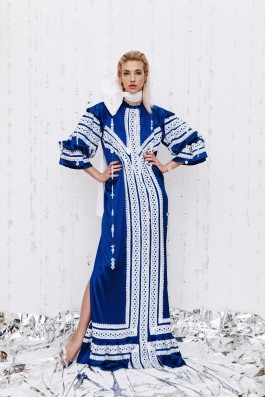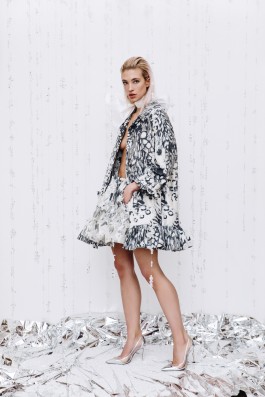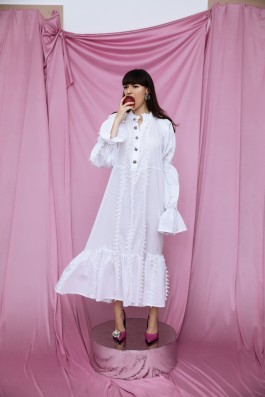


Successful graduates of UMPRUM (abroad): fashion designer Miro Sabo
Successful graduates of UMPRUM
They design furniture, paint, create fonts, and design clothing. Read interviews with UMPRUM graduates about their academic and professional experiences at home and abroad.
The world is (not) waiting for Czech fashion. First, a strong generation with an authentic opinion must be formed, says fashion designer Miro Sabo
Fashion first captivated the then high school student on the pages of the magazines he loved to flip through. Today he is an established fashion designer and the new head of the Fashion Design Studio. He founded his own brand focusing on custom design after his studies at UMPRUM in 2012. During the time he was managing it, he was able to continue his study abroad and complete several internships with various brands. What experience did he take from them into practice? And how is Czech fashion perceived internationally?
Collaboration with the international fashion industry is indispensable for the fashion designer and the practice of the school studio as well. "I think the borders are very permeable nowadays. Thanks to modern technology, various platforms help designers find factories and collaborations from different countries," Miro Sabo says.

Why did you choose UMPRUM and the Fashion Design Studio under the direction of Professor Josef Ťapťuch for your studies?
I applied to UMPRUM from an eight-year grammar school I studied in a town in eastern Slovakia. It was a different time, industry news, shows, and fashion weeks were delayed compared to today. My enthusiasm for fashion stemmed from flipping through Czech ELLE magazines, which were the most fashionable and basically the only magazine of its kind in the Czech Republic and Slovakia at that time. I followed the rise of now great designers such as John Galliano, and Alexander McQueen, who created avant-garde fashion that was very attractive to a person unfamiliar with the field. The "Galliano circus" interested me. The desire to pursue design then led me to apply to UMPRUM. The decision for UMPRUM was logical – there was no school with better prestige in the Czech Republic and Slovakia at that time. According to the available annotations, the direction of Professor Ťapťuch's studio was closer to me than the other studio then led by Helena Krbcová, which also focused on footwear and accessories. However, personal motivation did not play a role in the choice of the studio. At that time, out of some 120 people, 5 students were accepted into my year, so being accepted was a great success for me.
What international internships have you done? What was your reason for going abroad during and after your studies?
It was always emphasized at school, that foreign experience is absolutely essential for continuing to be functional in the field, and I agree. Working in another studio or company is irreplaceable, especially when there is not so much going on in the fashion industry in the Czech Republic. I managed to go to Paris during school, and then after school, I did another internship in Antwerp. For us, the study was designed as a six-year course, the division into bachelor's and master's degrees made it a bit more complicated in terms of internships, but I am still of the opinion that the more internships you do, the better – whether it is a study or work placement.

You studied textile design at ENSAAMA Olivier de Serres, Paris. What was the motivation for choosing this school and could you compare its approach with UMPRUM?
I chose this school because it had a partnership with UMPRUM and I was in Paris, where I simply wanted to travel. But it wasn't quite the equivalent of our school, as it was a so-called école supérieure, which is closer in character to a higher vocational school. The concept of teaching was quite loose, and the students mostly enrolled there without any previous experience in the field or any contact with artistic techniques, so they were starting from scratch. Soon, together with the heads of the studio, we decided that the level I had acquired so far at UMPRUM was quite a bit above the others and that I would find a work placement instead of studying there. That's how I got into Peclers.
How did your studies and professional experience in Paris and Antwerp enrich you and what practical experience did you take away?
One of the biggest benefits of the Paris experience was definitely the French language, which I learned through my internship. They didn't speak any other language in the company where I worked every day, so there was no choice. Within the agency, we looked a lot at the power of fashion visuals for where the industry and trends were headed. As an assistant designer, I was responsible for selecting imagery, working with looks, and doing research, all of which are important parts of any fashion practice. In Antwerp, I worked for Bruno Pieters, who at the time was just starting a new, now defunct, project called Honest By, which was the first completely transparent fashion brand. It was a very innovative and visionary thing; buyers could find out all the information about the origin of even the smallest details like buttons on the e-shop. A year later, I returned to Antwerp for an internship with Raf Simons, where I stayed for one season. This took me through the whole process from material selection to prototyping to the show, which is an indispensable experience for running your own brand.

How do you think Czech fashion is perceived abroad?
Czech fashion is hardly talked about abroad, but it is not necessarily because there is no interest in it. There is a plethora of creators in the world today and something major always has to happen in a given country for it to be known globally. This is also why the Czech Republic is known for glass, not fashion at the moment. The world is still (not) waiting for Czech fashion, but first, a strong and coherent generation with an authentic point of view has to be formed, just like in Belgium in the 1990s. Although historically a country with a strong textile tradition, it only became known and established as a fashion country after the creation of the Antwerp Six (an avant-garde group of designers formed in the 1980s in the middle of Antwerp's Royal Academy of Fine Arts, ed.). We are now seeing a similar evolution in Georgia thanks to the current generation of designers, the most famous of whom is Demna (designer, and creative director of Balenciaga and co-founder of Vetements, ed.). Who knew anything about the Georgian scene a few years back?
As a fashion designer, do you perceive any regional boundaries, either in terms of fashion thinking or purely practical in the execution of commissions?
I mainly recognise the boundaries of my studio and production, as I'm mainly involved in custom work. In terms of practice, I think local boundaries are very permeable nowadays. Different platforms help designers find factories and collaborations from different countries. Thinking about fashion has also shifted a lot in the last ten years. Locally, I think the credit for this goes to MBPFW (Mercedes-Benz Prague Fashion Week, ed.), which has been instrumental in changing the perspective of the target clientele in our country. Previously, designer fashion was perceived more as something that one buys to support the creator. There has been a big shift in this, with much more enthusiasm, joy, and professionalism accompanying the purchase.
Where are you currently based and do you have any international collaborations or experiences planned?
I am freshly working as the head of the Fashion Design Studio together with my assistant Monika Krobová. So I am addressing possible foreign collaborations on a personal level as well as on the teaching level. Connecting with real businesses that are happening abroad is crucial for the studio, but in the case of our newly taken-over management, these are still abstract and long-term plans. Relationships and contacts need to be built first, and this has to happen gradually. However, I am already noticing the interest of foreign brands to collaborate with our school. Personally, I am considering a short-term employment opportunity with a foreign brand. I probably won't be lucky enough to go for a few months, but sometimes a few days is enough.

Miro Sabo (*1986) graduated from the Fashion Design Studio at UMPRUM under the leadership of Professor Josef Ťapťuch, where he later worked as an assistant. During his studies, he completed an internship at ENSAAMA Olivier de Serres in the Textile Design studio in Paris, a nine-month work internship as a designer at the Peclers Paris agency, and with designer Bruno Pieters in Antwerp. After graduation, he continued to gain experience in international internships at Raf Simons in Antwerp and Nehera in Bratislava. In 2012, he founded his own fashion studio focusing on custom design and ready-to-wear collections. Since 2022, together with his assistant Monika Krobová, he has been running the Fashion Design Studio and at the same time working as an editor at Vogue CS magazine.
Interview conducted by Veronika Soukupová
Rozhovory s úspěšnými absolventkami a absolventy UMPRUM vznikly v rámci projektu Rozehrané priority českého předsednictví, podpořeného Centralizovanými rozvojovými projekty MŠMT ČR.